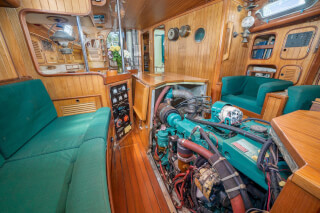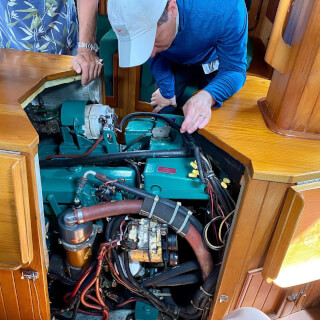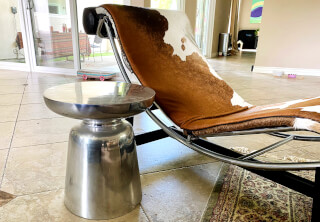Table of Contents

In today’s post, we want to update you on what’s happening over the next couple weeks. We’re now in Ft Lauderdale and staying at Hotel Circ once again.
Tropical Storm Sally moved across south Florida over the weekend, and another system is developing after Wednesday, which will affect our plans as rain and storm conditions are expected through the rest of the week.
Due Diligence
To prepare for this phase of the due diligence process, we gathered as much information as we could. The first resource was a “Limited Condition and Value Survey” that Bill had commissioned when he imported RJ Slocum into the US. He subsequently made it available to prospective buyers. The survey had some limitations due to
- lack of sea trial
- lack of machinery and equipment operation
Using this as a starting point, we knew more information would be needed to assess the structural integrity, which would require a comprehensive “Pre-purchase Survey.”

What can you expect?
Since some cruisers have documented their experience, we decided to aggregate and summarize our findings as a resource to you. In addition, you may want to check out their Youtube channels referenced on our Survey and Sea Trial playlist.
To begin, we had a one-on-one chat a couple months ago with John of Youtube sailing channel Hold Fast. In 2013, John bought his Cabo Rico 38 and began sailing the Chesapeake Bay. To date, he has accumulated over 15,000 nm on a number of great sailboats.
As many other sailors have commented, John said we would have our hands full when it comes to maintenance. Given s/v Rachel J Slocum is 30 years old, there will be a lot of projects. A quality surveyor conducting a pre-purchase survey will investigate the structural integrity of the yacht including the state of the following:
- teak decks - if there is moisture in the deck from being screwed into the sub-deck, then $1,000 per linear foot in U.S. (or $500 per linear foot in Grenada) to remove all the old teak, cut off top skin, remove rotten core, replace closed cell foam, reglass and paint
- rudder - at that age could be a bit wet
- chainplates and standing rigging - should be changed if they are older than 20 years
- wiring and plumbing - could be a problem; usually need to change water hoses and wiring after 20-25 years
Along with our quick chat, his Hold Fast Youtube channel has a few survey and sea trial videos, including: Cabo Rico 38 Pilothouse, Sea Sprite 34, Passport 37, Passport 47, Cabo Rico 38
We are going into this phase hoping for the best and expecting the worst.
“Hoping for the best” means that everything described in the previous survey and everything described by Bill (who has done continuous upgrades and refits over the years) means she truly is ready to go.
“Expecting the worst” means staring down the barrel of $100K in refit costs before the first season of sailing and therefore walking away from the boat.

Lessons from armchair sailing
In addition, we also checked out various sailing channels, which are categorized in the following buckets: newbies and old salts (a.k.a. experienced newbies because this lifestyle requires us to always be learning).
From Newbies
Gone with the Wynns - Jason and Nikki bought a 2005 Leopard 43 without ever having sailed before. This episode covers the highlights of the marine survey (08:00 to 16:00) and sea trial (roughly 30 minutes), which was done all on the same day. Coming out of it, they had a better understanding of the upkeep and maintenance that would be required of them. After 48-72 hours, they would have both results from the oil samples and the written survey to know how much additional money to invest in the catamaran before sailing away. Given about $20K worth of work would need to be done in the next 1-2 years, they decided to counter with a $10K reduction in their offer price.
Abandon Comfort - Ryan and Kelsey hired a surveyor for their first boat, who discovered at least 7 months of work on the hard and a minimum of $12K in materials, so they walked away from the deal. Ironically, when they located a second Hallberg-Rassy 352 sitting in Indianatown, they foregoed the process entirely and bought Lucy as is.
Sailing Millennial Falcon - With the benefit of hindsight, Adam admitted he put a lot of faith in the survey for their 1981 Tayana 42. “We got a favorable survey and expecting to have that security and to be able to take that to the bank. In truth, most of the things that passed in the survey, either died almost immediately after or we could never recreate again the condition that was presented in the survey.” If he were to hire a surveyor, he wouldn’t do it to have that security blanket. He continues, “I would want the nuanced details of the boat that you can only get through a lifetime of experience.”
The Boat Life - Nic and Melissa closely followed their surveyor during each step of the process of their Island Packet 27, who gave them (for example) alternatives for replacing their battery banks, or indicated the water heater is on the last legs, but functional. It helped them to validate the offer price and identify where they would need to begin spending to replace as the equipment reached the end of its useful life.
Sailing Nervous - Vin and Amy covered the survey process of a Moody 34 over the course of a 2-part series: Part 1 for survey & haul out and Part 2 for sea trial. The surveyor recommended the following: 3 blade feather and new shaft installation, replace cutlass bearing, gel coat blistering is cosmetic but will get worse (penetrating the hull) and replace seacocks.
Wandersailing - Eric and Natalie are upgrading to a 1988 Catalina 34, and this survey began in the water to evaluate the engine and equipment. In retrospect, they didn’t think the survey was thorough, falling short of the following: the surveyor should climb to inspect the mast and rigging, examine the lazarettes, and complete a full inspection of the electrical and steering systems, plumbing and hull integrity. Sure seems like they got short-changed.

From Old Salts
The O’Kelly’s - based on common questions that came up during their consultancy, the O’Kelly’s did a round-up video describing various items to consider if you’re buying a cruising boat. I found the deal breaker section particularly useful.
Grampian Marine - This is a DIY for a limited condition and value survey that could be used for insurance purposes.
Sailboat Rigging Survey - This episode covers only the standing rigging, running rigging and sails however it goes through the review in a great bit of detail. Andrew found it particularly entertaining.
Second Hand Smitty - Here is another DIY version following Don Casey’s book to conduct a 30 minute survey a 1977 Cape Dory 28. I really like the information shared in this video, especially the title scrawl that annotates the tips from Don Casey’s book.
Port Credit Marine Surveys - Saving the best for last… this is a Marine Survey 101 which will save you hundreds of dollars if you’re willing to make some observations to identify red flags for yourself and avoid having to hire a surveyor more than once. We have added this link to our resources page.
Takeaways
Based on these videos, here are my takeaways:
- be sure to wear kneepads
- bring something to sand or file down debris
- bring a small handheld mirror/camera to look behind tight locations
- note location and condition of zinc
- take copious notes or capture with audio or video
A more comprehensive list can be found in the Marine Survey 101 from Port Credit Marine Surveys. However, as mentioned before, one of our shortcomings is not knowing the cost of repairs. What are newbies to do? Hire an expert. An accredited marine surveyor would be able to supply you with those rough estimates.

Hire an Expert
Luckily, our surveyor isn’t a one-trick pony. Ian Gardner of Yacht Refit Management has over 40 years of experience in the marine industry and offers a wide range of services including project management of refit and new construction, repairs and operation on all types of yachts.
He is also an Accredited Marine Surveyor (SAMS), graduated from an apprenticeship with Ship & Yacht Construction & Design (NZ), has an MCA Master Class 4 license with over 250,000 logged sea miles on race yachts and both private/charter, sail and motor yachts. Among the services for marine survey are new construction, pre-purchase, appraisals, insurance, damage and maintenance. The description of what is involved in a sea trial is also worth checking out.
Here’s what they have to say about the pre-purchase survey:
We test and monitor all systems, equipment and known areas of potential stress and failures. We load up, increase demands, pressurize, over exert, redline, and push the limits on all operating systems and equipment that we know they need to be capable of until we and the owner and/or operator are satisfied.
As for maintenance:
Experience alone is the only qualification upon which any decisions can be made when writing specifications or providing advice on yacht construction/refit, maintenance, equipment, systems, materials and operation. YRM has been using, testing, replacing, evaluating and recommending the different options available to use in the many designs and budgets and operations we have been involved in during the last 4 decades and know what works best for what is required.
Head’s up
Because Bill had started working on the boat in August, Ian had a chance to do the in-water survey and provide some feedback on areas that needed attention, for example the heat exchanger.
We had a chance to chat with Ian in advance of our trip to Florida, and he shared with us some of his findings. We also solicited his advice on which boatyard in Ft Lauderdale he trusted to do bottom paint. As much as we will become DIY boaters, we have a lot on our plate and the best use of our time isn’t painting. As we explore in a future post, we have plenty of work cut out for us during our 2 weeks in Ft Lauderdale.
Hope you find this post helpful. Stay tuned for the next installment on Thursday after we have a chance to do the haul out and marine survey.
More from this series:
- Survey & Sea Trial Part 1
- Survey & Sea Trial Part 2
- Survey & Sea Trial Part 3
- Survey & Sea Trial Part 4
- Survey & Sea Trial Part 5
Thanks for reading!
Share Survey & Sea Trial Part 2 with your friends:
Stay up to date with our content releases, by subscribing to our RSS Feed or follow us on Facebook and Instagram.
 If you would like to delve deeper into our adventure as it unfolds, please consider joining the Serenade Wind Crew. Our sister site provides more information on what it means to be part of the crew, unlock the pirate’s booty, and receive other exclusive access and benefits.The first 50 members have a gift waiting.
If you would like to delve deeper into our adventure as it unfolds, please consider joining the Serenade Wind Crew. Our sister site provides more information on what it means to be part of the crew, unlock the pirate’s booty, and receive other exclusive access and benefits.The first 50 members have a gift waiting. 